Not everyone enjoys the earthy taste and of mushrooms. However, fungal organisms are truly remarkable as they have evolved into a wide variety of colors, shapes, and sizes. In fact, some look so weird you can’t help but wonder if they were modified in a science lab… So how did these cool-looking mushrooms come about, and what makes them so interesting?
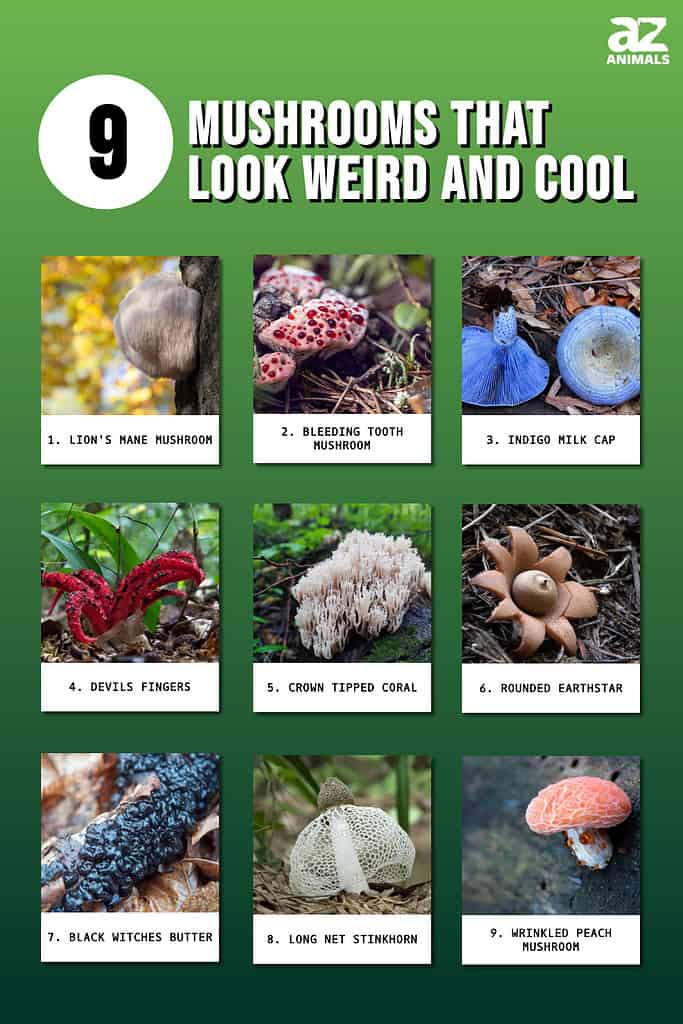
Well, for starters, did you know that mushrooms are not plants? This is because fungi are in their own kingdom. They do not produce roots, leaves, or chlorophyll. Fungi possess an uncanny ability to adapt effectively over time. These adaptive traits build up gradually and eventually can transform into completely novel species of mushrooms.
From the stinkhorn mushroom that emits a repugnant scent and attracts flies for spore dispersal to the indigo milk cap that secretes a milky blue liquid giving it an unusual appearance.
Nonetheless, next time you go exploring mother nature, keep a look out for these unique and fascinating specimens. Who knows what you might find?
The Bearded Tooth Mushroom (Hericium erinaceus)
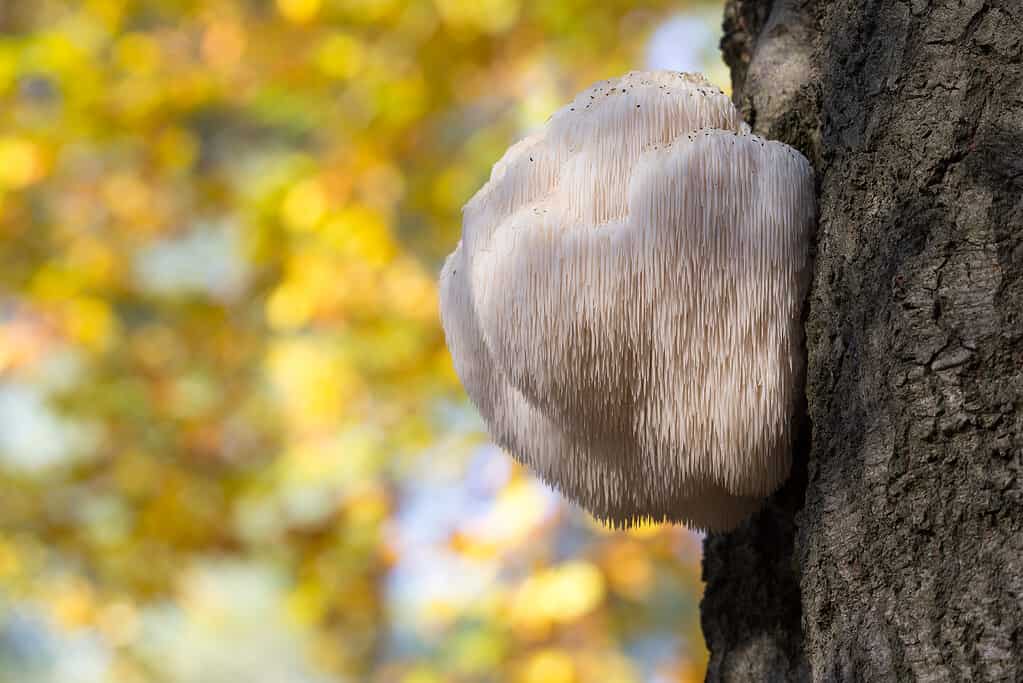
A beautiful lion’s mane mushroom growing from a tree.
©Gertjan Hooijer/Shutterstock.com
The shaggy appearance of this mushroom is so striking that it has earned itself the nickname the Lion’s Mane Mushroom. Not only is it widely recognized for its aesthetic qualities but there are studies that propose several possible medicinal properties. This mushroom has played a significant role in various Asian healing practices and is thought to exert multiple health advantages, such as aiding digestion, enhancing immunity, and promoting neural tissue growth.
Being a saprotrophic mushroom, it acquires sustenance by consuming dead or decaying wood and breaking down cellulose and lignin into simpler compounds usable for energy. Its existence plays a noteworthy role in advancing nutrient cycling procedures within forest ecosystems.
The Bleeding Tooth Mushroom (Hydnellum peckii)

A captivating pic of the unique looking Hydnellum peckii
©Julija Kumpinovica/Shutterstock.com
This bizarre mushroom is obviously weird and cool. The bleeding tooth mushroom resides in North America, Europe, and Asia. The Bleeding Tooth Mushroom looks ghastly enough to deter even the bravest souls with its spongy texture and bright red cap.
However, despite its horrific appearance, it is not poisonous and safe for consumption. That said, its taste can be unfavorable to many because it is often described as having a bitter flavor. It might not be pleasing to the eye, but some people say it might serve a purpose in healing ailments of respiratory and digestive issues. If you are looking for this organism, be sure to head out late summer and early fall as these are the ideal seasons to spot. The bleeding tooth mushroom, typically found sprouting on the forest floor in close proximity to coniferous trees.
Indigo Milk Cap (Lactarius indigo)
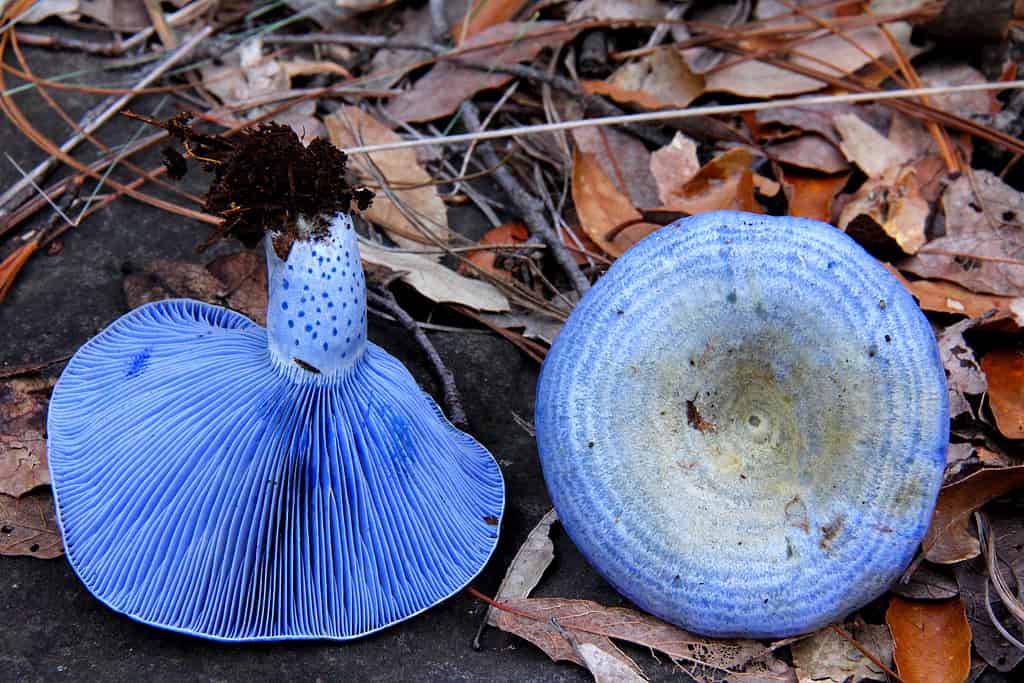
A top and bottom look at this beautiful mushroom.
©Gajda/Shutterstock.com
The indigo milk cap mushroom stands out from many other mushrooms thanks to its brilliant blue pigmentation. You may be able to find some other species that look similar on top, but none have these beautiful blue gills or blue latex. This mushroom exhibits a multitude of different shades of blue depending on age. These colors are not commonly found in nature. Interestingly, the pigment behind this striking coloration is indigotin – a compound utilized to produce indigo dye.
The indigo milk cap mushroom is commonly found alongside conifer trees which play a significant role in the forest ecosystem. Because of this, it exists in a mutually beneficial relationship with these trees, known as a mycorrhizal relationship or some people just call this symbiosis. Therefore, the mushroom provides nutrients to the tree while receiving sugars from it, which allows both organisms to thrive and maintain a well-balanced ecosystem.
Devils Fingers (Clathrus archeri)

A beautiful pic of a very weird and cool looking mushroom.
©iStock.com/LeoMalsam
The octopus stinkhorn mushroom was an Australian and New Zealand native species. However, this fungus has gained entry to numerous other locations, including Europe and North America. It has garnered attention for its peculiar shape resembling a red or pink hand covered in sticky tentacles. These structures may smell dreadful, but they serve to lure flies and other insects that help distribute the mushroom’s spores. Pseudocolus fusiformis can look quite similar to the untrained eye.
This mushroom grows on the ground in damp and shaded environments like woodlands or gardens, where it obtains nutrients from decomposing organic matter. While non-toxic, it is unpopular for human consumption due to its slime-like texture and unpleasant aroma.
Crown Tipped Coral (Artomyces Pyxidatus)
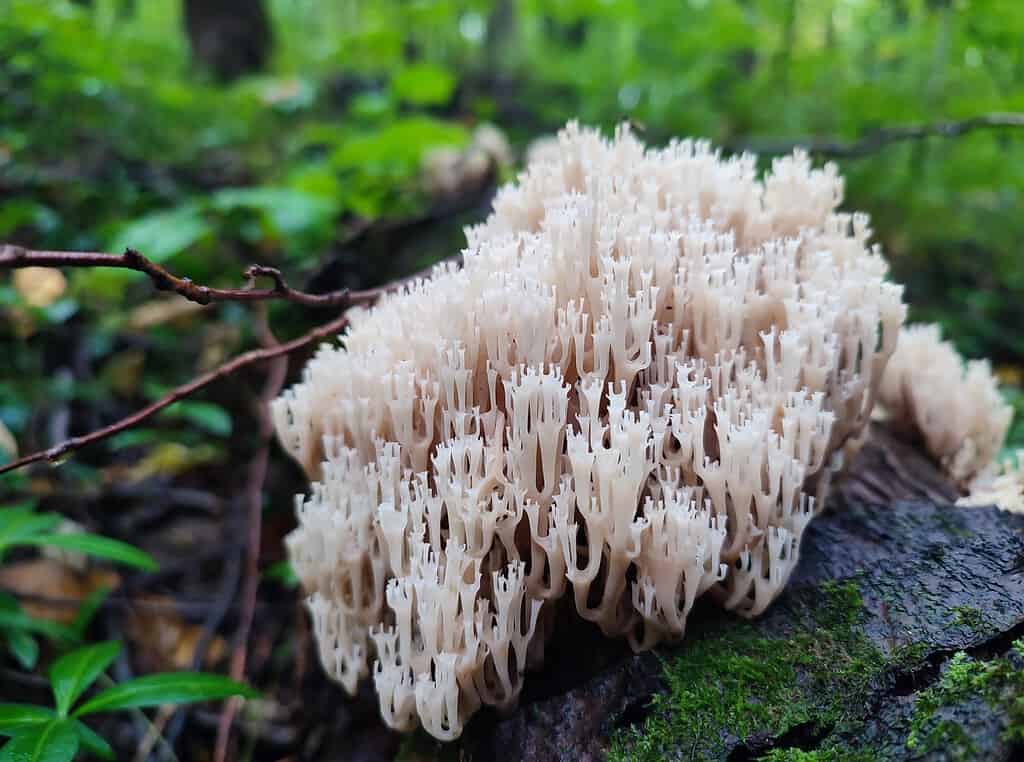
Looking like it’s straight from the ocean floor, coral mushrooms are beautiful.
©Kristini/Shutterstock.com
Coral mushrooms resemble coral from the sea. While there are many different mushrooms out there that people call “coral”, this one is relatively distinct looking. Artomyces Pyxidatus is unique from most other coral mushrooms in that it grows directly on wood. It also has a distinct “crown tipped” top. This coral mushroom is common on the east coast of the United States, but pretty rare on the west coast.
Many of the mushrooms out there that are referred to as coral are in the genus Ramaria. Those mushrooms have questionable edibility and are extremely hard to identify to species. This mushroom is a lot easier to ID with its slender appearance, grouping, white color and the fact that it grows on wood. The people that eat these seem to enjoy them and some say they even have a peppery taste to them.
Rounded Earthstar (Geastrum saccatum)
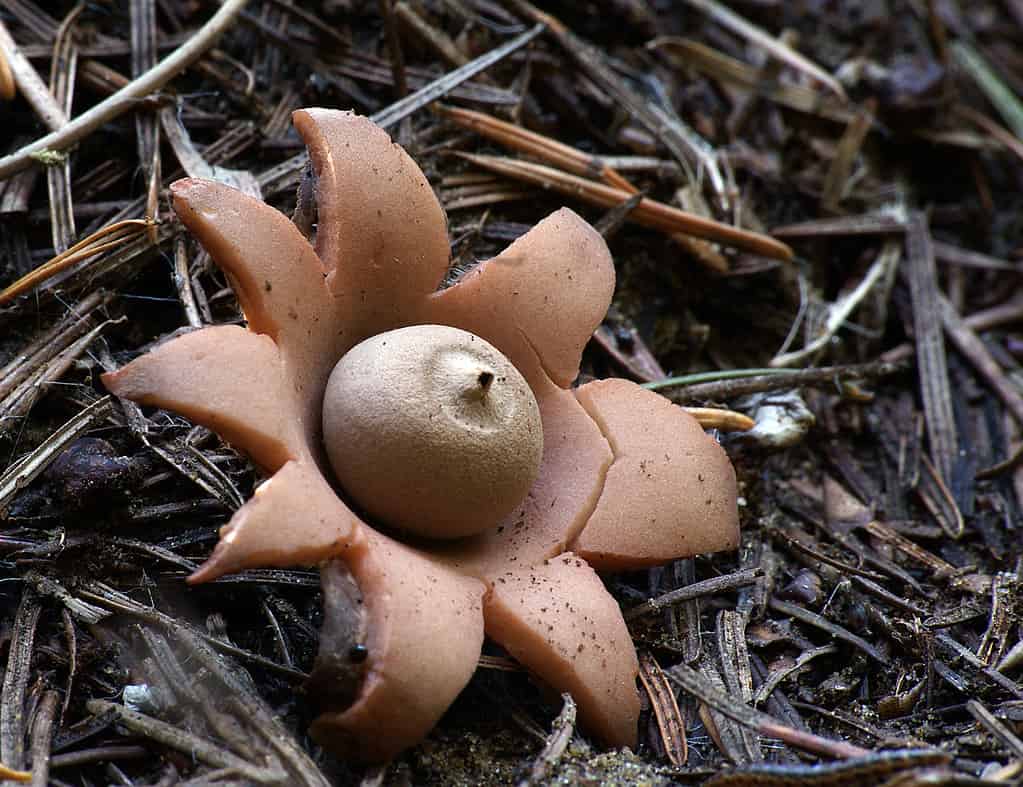
Close up of Geastrum saccatum.
©lego 19861111/Shutterstock.com
The mushroom’s unique shape is the reason for its name, as it is reminiscent of a round ball when closed and transforms into a star-like shape when open. That is why they are commonly called earthstars. In its early stages, the rounded earthstar mushroom is characterized by a smooth exoperidium that entirely encloses it. Later, the outer layer splits open into several rays to reveal an inner endoperidium that bears the spores. This particular layer features an ostiole at its center, providing a means for these spores to emerge in readiness.
Although the rounded earthstar mushroom does not possess any poisonous attributes, it is typically regarded as unsuitable for consumption owing to its unyielding, leather-like consistency and absence of taste.
Black Witches Butter (Exidia glandulosa)

A close up of Exidia glandulosa aka black witches’ butter.
©Svitlyk/Shutterstock.com
The black witches’ butter mushroom is primarily found in North America and Europe, mainly in deciduous trees, especially oak. Noted for its gelatinous and rubbery texture, the black witch’s butter mushroom typically boasts a dark black coloration.
This intriguing fungus possesses a remarkable quality of adapting to its environment. This mushroom starts out as small asymmetrical blobs, but eventually turns into a black crust.
Long Net Stinkhorn (Phallus indusiatus)
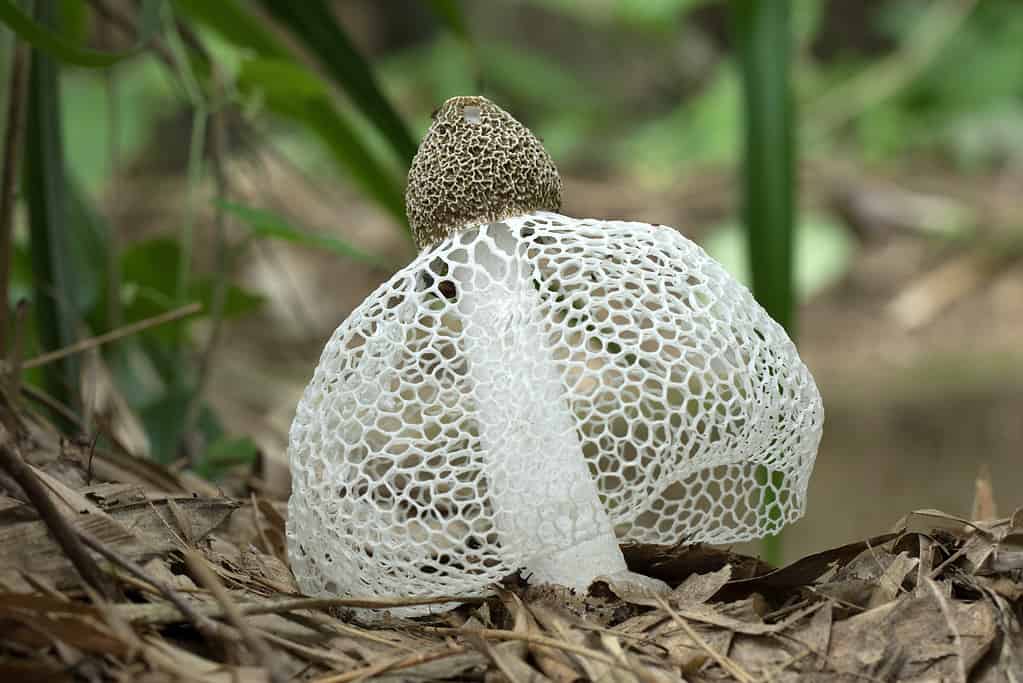
A majestic picture of Phallus indusiatus
©bamgraphy/Shutterstock.com
There are many weird looking stinkhorn mushrooms out there, so we thought it would be a good idea to add another one to the list. Phallus indusiatus is a beautiful mushroom certainly worth mentioning. Its natural habitat tends to be near disturbed areas, growing on wood debris. Unique in shape, this fungus sports a fruiting body that resembles other stinkhorns in regards to the cap and stem, but then has a beautiful netting around it, almost like a veil with holes in it, or a net. When it is young, this mushroom takes on more of an egg shape as many other stinkhorns do. This mushroom can be find almost world wide in the tropics.
As the name stinkhorn would suggest, this mushroom smells extremely bad and is reported to be able to be smelled from a distance. Some people say that they eat them in egg form, but this isn’t a common practice. There are some other rumors out there that just smelling this mushroom can give a woman an orgasm, we find this claim highly unlikely.
The Wrinkled Peach Mushroom (Rhodotus palmatus)
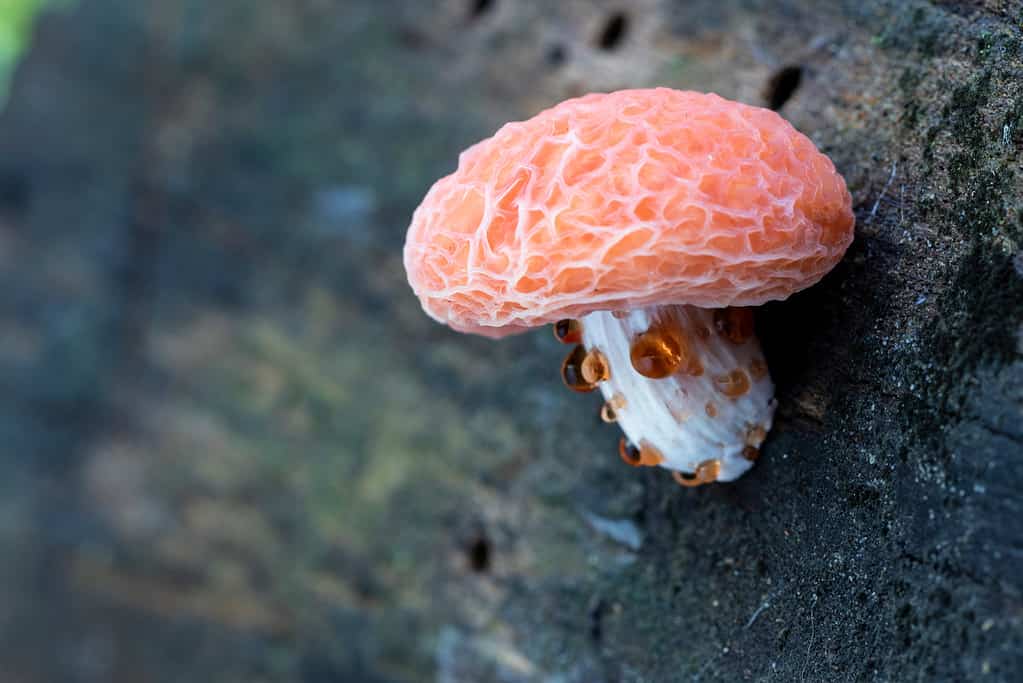
An exceptionally gorgeous photo of Rhodotus palmatus
©John Navajo/Shutterstock.com
I think we have saved the best for last. One of our favorite looking mushrooms, Rhodotus palmatus, is quite distinct. Although you may see some clickbait type sources claim that this is one of the most rare and endangered mushrooms in the world, it is actually not all that uncommon in the United States all the from Pennsylvania out to Illinois. This mushroom can also be found in Asia and Europe. In Europe it has made some European fungal red lists due to habitat loss.
When it looks like this, this mushroom is relatively easy to ID as there isn’t much else out there that looks like it. But, it isn’t always quite so beautiful and showy. Many of times it is a more normal looking mushroom with a little bit of peach color and isn’t near as outstanding. You can find Micheal Kuo cracking some jokes about all of this in his article seen here.
The photo featured at the top of this post is © iStock.com/LeoMalsam
The information presented on or through the Website is made available solely for general informational purposes. We do not warrant the accuracy, completeness, or usefulness of this information. Any reliance you place on such information is strictly at your own risk. We disclaim all liability and responsibility arising from any reliance placed on such materials by you or any other visitor to the Website, or by anyone who may be informed of any of its contents. None of the statements or claims on the Website should be taken as medical advice, health advice, or as confirmation that a plant, fungus, or other item is safe for consumption or will provide any health benefits. Anyone considering the health benefits of particular plant, fungus, or other item should first consult with a doctor or other medical professional. The statements made within this Website have not been evaluated by the Food and Drug Administration. These statements are not intended to diagnose, treat, cure or prevent any disease.
Thank you for reading! Have some feedback for us? Contact the AZ Animals editorial team.






